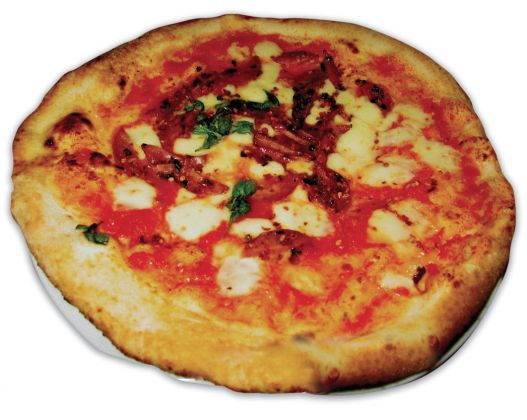Napoli, bella Napoli, is a quixotic mixture of humanity with a captivating and seductive character that is unlike any other city in Italy. In Napoli, passion pervades daily life, and perhaps nowhere is this more evident than where food is concerned. If food is what keeps that passion burning, then arguably pizza is the favorite fuel of Neapolitans.
After only a few days in Napoli it becomes readily apparent that this is a city that lives to eat and that here one regional specialty reigns above all others. Pizza is the gastronomic epicentre of a culture obsessed with food. If you stop Neapolitans on the street and ask about the origin of pizza, they will state without hesitation that real pizza was invented in Napoli, and proudly boast that theirs is the most delicious in all of Italy.
In fact many locals make the bolder claim that it is the best pizza in the world. Any rebuttal to this statement will be countered by one or more of the following: a dismissive wave, a menacing stare, a snorting laugh, or a tender smile coupled with a gentle side to side shake of the head. You see, where pizza is concerned the honour of bella Napoli cannot be challenged, period! After the privilege of several lengthy visits, I count myself among the converted, and I will now eagerly defend Napoli’s claim of global pizza supremacy from any and all challengers.
That pizza in Napoli is undeniably delicious is only part of its allure. The culture which surrounds this local staple is captivating, the perfect complement to the pizza itself. Each pizzeria in Napoli offers a slightly different snapshot of pizza culture merged with daily life. It is the subtly unique personality of each pizzeria that wins it those fiercely loyal aficionados. Passionate street debates frequently erupt between groups, as each member campaigns to sway friends towards his or her pizzeria of choice for that evening’s meal.
On past visits, whenever I have found myself embroiled in one of these debates, I have always cast my vote for Antica Osteria del Gallo. I was hooked on my first visit after the waiter placed a brazier full of glowing embers from the pizza oven underneath our table to ward off the November chill. What atmosphere! It was like traveling back in time.
Antica Osteria del Gallo was founded in 1898 and is still family owned, with grandson Rosario Silvestri now manning the oven. It is sandwiched between the Fontanelle and Sanità neighbourhoods at the foot of Materdei Hill. If you visit, be sure to sample pagnottiello, a house specialty that is best described as hors d’oeuvre size calzoni, the perfect appetizer! If you speak passable Italian then go for a late lunch and chat up Rosario. He is very animated, both in conversation as well as behind the oven, and he has some fascinating stories about his family’s first century in the pizza business.
Of course pizza predates the Silvestri family by more than a few centuries. Ancient legends recount how Roman soldiers, upon their return to Italy, developed a dish that they called picea, based on the matzoh they had sampled during their campaigns in Palestine. This ancestor of pizza, cooked bread with oil and spices on top, would be more akin to what is now called focaccia. In Napoli this early form of pizza quickly became a popular staple in the diet of the peasant class for centuries thereafter.
From these humble origins the modern pizza evolved, but it took until the nineteenth century for all the pieces of the puzzle to fall into place. Firstly, the water buffalo appeared in Campania, via India, during the seventh century, and with it came the milk that was essential for mozzarella cheese. The last piece in the puzzle was the tomato, which made its way to Italy from the New World, via Spain, during the sixteenth century. Ironically, it was thought to be poisonous, and so for its first few centuries in Italy it was not eaten but rather was kept strictly as an ornamental plant. Neapolitans are considered to be among the first peoples to adopt the tomato into their daily cuisine.
With all the pieces of the puzzle now available, it became a matter of putting them all together. Local history recounts that it was the pizzaiolo Raffaele Esposito of Napoli, who in 1889 combined tomatoes, mozzarella cheese, and basil as pizza toppings, in a colourful and patriotic tribute to the tricolour Italian flag. Legend has it that Raffaele drew his creative inspiration from the visit of the Italian King Umberto and Queen Margherita to whom he served his new pizza alla Margherita. This new pizza style became extremely popular and versions of it spread throughout the globe, as many Neapolitans emigrated in the late nineteenth and early twentieth centuries and brought their culinary traditions with them as they settled in their new lands.
Of course, even the best quality of ingredients and most congenial atmosphere will not realize their full potential without proper guidance. Central to the creation of a great pizza, and thus a great pizzeria, is the pizzaiolo. He is an artist who has chosen to express his culinary creativity with dough as his canvas, and with tomato sauce and mozzarella as his oils. One must be born into the profession, as the skills are not taught in any school. Jealously guarded family recipes are handed down over generations from father to son in this male-dominated profession.
Rumour has it that true Neapolitan pizzaioli can find work around the globe, such is their renown. They bring a ritualistic attention to detail to the task at hand. Their pizza dough, left to rise for as long as thirty-six hours, and other ingredients, are prepared daily to ensure optimum freshness. Similar importance is paid to the daily building of the wood fire in the oven. Typically, it will burn for hours in order to prepare the oven for the first of many pizzas to be cooked that day. A pizzaiolo will turn away potential customers, advising them to return in an hour or two, if his oven has not reached the optimal state required to produce the perfect pizza.
From shaping the dough to tending the pizza while it is cooking, all pizzaioli exhibit varying degrees of style or flare as they practice their craft. Perched by their ovens, these showmen snatch occasional glances at the clientele seated in the restaurant, obviously intent on ensuring their pizzas are being enjoyed to the fullest. Watching the pizzaioli at work and their spirited interaction with other staff is a very entertaining way to pass the time while one’s pizza cooks.
Dining in a Neapolitan pizzeria is a multi-sensory experience – one that immerses you in the culture of food that pervades Napoli. Delicious pizza tantalizing your palate, entertaining pizzaioli, and animated locals at the adjacent tables all combine to give you a unique gastronomic experience. These are experiences that will live on in both your memory and in your taste buds – experiences that are certain to have you longing for a return visit to bella Napoli to once again partake in the passion of the pizza culture.
First published in Accenti Magazine, Issue 16.




